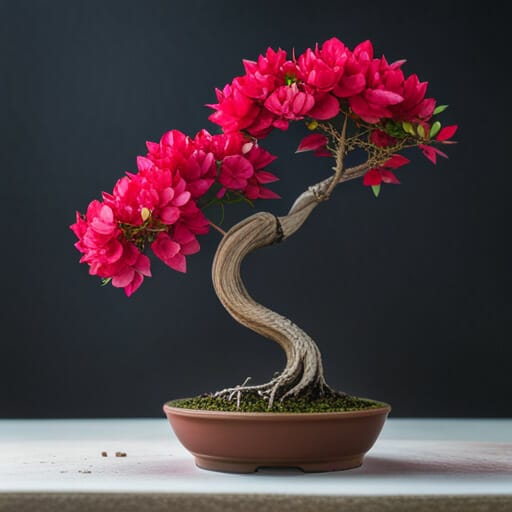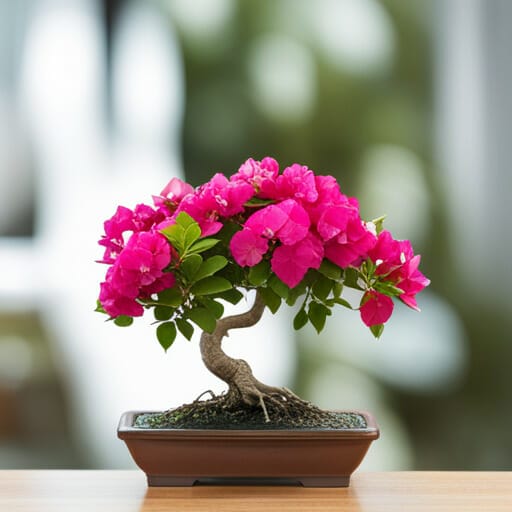Bougainvillea bonsai, with its vibrant scarlet or pink flowers, is a captivating art form in the world of bonsai gardening. Like a skilled artist shaping clay into a masterpiece, bonsai enthusiasts carefully cultivate and nurture these tropical plants to create stunning miniature trees.
Native to South America, the bougainvillea bonsai is beloved for its easy care requirements, making it an ideal choice for those with limited space, such as apartment dwellers. With proper care and maintenance, this evergreen shrub can thrive both indoors and outdoors, adding a touch of natural beauty to any environment.
This comprehensive guide will delve into the intricacies of caring for bougainvillea bonsai, from shaping and styling techniques to indoor care tips. Whether you are a seasoned bonsai gardener or a beginner, this article will provide valuable insights to help you master the art of bougainvillea bonsai.
Contents
- 1 Quick Points
- 2 Care and Maintenance
- 3 Shaping and Styling
- 4 Indoor Care Tips
- 5 Frequently Asked Questions
- 5.1 Can bougainvillea bonsai trees be grown from seeds?
- 5.2 How often should I prune my bougainvillea bonsai tree?
- 5.3 Can I use tap water to water my bougainvillea bonsai tree?
- 5.4 What are some common mistakes to avoid when caring for bougainvillea bonsai trees?
- 5.5 Can bougainvillea bonsai trees be trained into a specific shape or style?
Quick Points
- Bougainvillea bonsai trees are easy to care for and suitable for apartments or small spaces.
- They require at least 6 hours of direct sunlight daily and prefer humidity levels between 40% and 60%.
- Pruning should be done in spring after new growth, and branches can be wired when the tree is 1-2 years old.
– Repotting should be done every two to three years when younger and smaller, with careful removal of the rootball to avoid damaging roots.
Care and Maintenance

Care and maintenance of bougainvillea bonsai trees is essential for their health and aesthetic appeal. This requires:
- Proper watering, ensuring that the soil is light and airy with good drainage. Watering should be done when the top inch of soil is dry.
- Adequate sunlight, with at least 6 hours of direct sunlight daily.
- Appropriate temperature and humidity levels, with the ideal temperature range between 60 and 75 degrees Fahrenheit and humidity levels between 40% and 60%.
- Regular pruning, which should be done in the spring after new growth.
- Timely repotting, necessary every two to three years for younger and smaller trees.
With proper care, bougainvillea bonsai trees can thrive and exhibit their unique charm, making them a popular choice for bonsai gardening enthusiasts.
Shaping and Styling

Shaping and styling the vibrant vines of bougainvillea bonsai involves delicate handling of the foliage and training the slender stems to create captivating contours. The art of bonsai allows for various styles to be applied to bougainvillea trees, each showcasing its unique charm. Some popular styles include the formal upright, broom, informal upright, slanting, cascading, and landscaping. With proper care and patience, these bonsai trees can exhibit their full potential within a few months or one growing season. To provide an engaging overview of these styles, the following table illustrates the characteristics and visual representation of each style:
| Style | Characteristics | Visual Representation |
|---|---|---|
| Formal Upright | Straight, tapered trunk with branches gradually decreasing |  |
| Broom | Straight, symmetrical branches resembling a broom |  |
| Informal Upright | Twisted, asymmetrical trunk with branches at uneven angles |  |
| Slanting | Slanted trunk with branches angling upwards or downwards |  |
| Cascading | Trailing branches cascading downwards |  |
| Landscaping | Multiple trunks with branches resembling a miniature forest |  |
By understanding these styles and applying proper techniques, bonsai enthusiasts can shape and style their bougainvillea bonsai trees to create visually striking and captivating displays.
Indoor Care Tips

Indoor care for bougainvillea bonsai trees involves providing ample light, maintaining warm temperatures, and ensuring high humidity levels.
These tropical plants thrive in bright, indirect light, so placing them near a south-facing window or using grow lights is essential.
Temperature-wise, they prefer a range between 60 and 75 degrees Fahrenheit, making them suitable for most indoor environments.
To maintain the required humidity levels, misting the leaves regularly or placing the bonsai on a tray filled with water and pebbles can be effective.
Additionally, grouping the plants together can create a microclimate with increased humidity.
It is important to note that frost or freezing temperatures can be detrimental to bougainvillea bonsai trees, so they should be protected during colder months.
By providing the right conditions, indoor bougainvillea bonsai trees can thrive and add beauty to any space.
Frequently Asked Questions
Can bougainvillea bonsai trees be grown from seeds?
Bougainvillea bonsai trees can be grown from seeds, although it is a more challenging and time-consuming process compared to other propagation methods like cuttings. It requires proper care and patience to achieve successful germination and growth.
How often should I prune my bougainvillea bonsai tree?
Pruning frequency for bougainvillea bonsai trees depends on the desired shape and growth. Regular pruning, typically done in spring after new growth, helps maintain the tree’s size and shape. It is essential to follow proper pruning techniques to ensure healthy growth.
Can I use tap water to water my bougainvillea bonsai tree?
Tap water can be used to water bougainvillea bonsai trees, but it is important to consider the quality of the tap water. Some tap water may contain high levels of minerals or chemicals that can be harmful to the tree. It is recommended to use filtered or distilled water if possible to ensure the tree’s optimal health and growth.
What are some common mistakes to avoid when caring for bougainvillea bonsai trees?
Common mistakes to avoid when caring for bougainvillea bonsai trees include overwatering, insufficient sunlight, improper pruning, using heavy or compacted soil, neglecting to fertilize regularly, and exposing the tree to freezing temperatures.
Can bougainvillea bonsai trees be trained into a specific shape or style?
Bougainvillea bonsai trees can be trained into various shapes and styles, including formal upright, broom, slanting, cascading, and landscaping. With careful care and pruning, these trees can exhibit their charm within a few months or a growing season.




